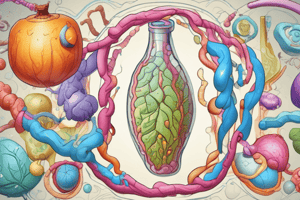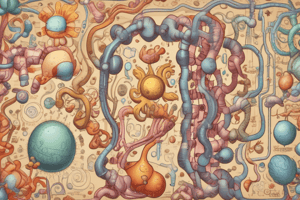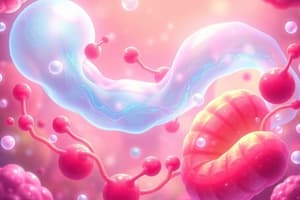Podcast
Questions and Answers
Where does fatty acid synthesis occur?
Where does fatty acid synthesis occur?
Cytosol
What is the principal building block of fatty acids?
What is the principal building block of fatty acids?
- Malonyl-CoA
- Propionyl-CoA
- Citrate
- Acetyl-CoA (correct)
Fatty acid oxidation occurs in the mitochondria.
Fatty acid oxidation occurs in the mitochondria.
True (A)
Free palmitate must be activated to ___________ before it can proceed to any metabolic pathways.
Free palmitate must be activated to ___________ before it can proceed to any metabolic pathways.
Match the fatty acid synthesis enzyme with its function:
Match the fatty acid synthesis enzyme with its function:
Where does fatty acid elongation occur?
Where does fatty acid elongation occur?
Which enzyme catalyzes the formation of monoenoic acids?
Which enzyme catalyzes the formation of monoenoic acids?
Linoleic acid is considered essential in the diet. (True/False)
Linoleic acid is considered essential in the diet. (True/False)
______ acids are particularly needed for the development of the brain and retina.
______ acids are particularly needed for the development of the brain and retina.
Match the following compounds with their roles:
Match the following compounds with their roles:
What specific pathway involves the consumption of two molecules of O2 by cyclooxygenase?
What specific pathway involves the consumption of two molecules of O2 by cyclooxygenase?
Flashcards are hidden until you start studying
Study Notes
Metabolism of Lipids (Fatty Acids & Eicosanoids)
Biosynthesis of Fatty Acids
- Fatty acids are synthesized from acetyl CoA and oxidized to acetyl CoA
- Fatty acid synthesis occurs in the cytosol, while fatty acid oxidation occurs in the mitochondria
- Major sites of lipogenesis: liver, adipose tissue, mammary gland, kidney, lung, and brain
- Free palmitate is the end product of fatty acid synthesis, and all other fatty acids are made by its modification
Fatty Acid Activation
- Fatty acid activation involves the conversion of free fatty acids to acyl-CoA, catalyzed by acyl-CoA synthetase
Enzymes Involved in Fatty Acid Synthesis
- Malonyl-CoA is formed from acetyl-CoA through the action of acetyl-CoA carboxylase (ACC)
- Fatty acid synthase (FASN) is a multienzyme complex that catalyzes the synthesis of fatty acids
- FASN has 7 enzymes and a protein (Vitamin B5 - Pantothenic acid)
Rate-Limiting Step in Fatty Acid Synthesis
- The formation of Malonyl-CoA is the rate-limiting step in fatty acid synthesis
- Acetyl-CoA carboxylase (ACC) is activated by citrate, insulin, and dephosphorylation, and inactivated by glucagon/epinephrine and phosphorylation
Fatty Acid Synthesis: Lipogenesis
- Fatty acid synthesis involves the sequential addition of 2-carbon units from malonyl-CoA to the activated end of the chain
- The process is repeated seven times to form a 16-carbon saturated palmitate
- Palmitate is the final product of fatty acid synthase complex
Sources of NADPH
- Pentose phosphate pathway is the chief source of NADPH for fatty acid synthesis
- Other sources of NADPH include the conversion of malate to pyruvate by malic enzyme and the extramitochondrial isocitrate dehydrogenase reaction
Fate of Palmitate
- Palmitate is activated to acyl-CoA before it can proceed to any metabolic pathways
- Palmitoyl-CoA can be esterified to acylglycerols, cholesteryl esters, or undergo chain elongation and desaturation
Chain Elongation
- Fatty acid elongation occurs in the endoplasmic reticulum
- Elongases use malonyl-CoA as the acetyl donor and NADPH as the reducing power
- Palmitoyl-CoA is converted almost exclusively to stearate (18:0)
Formation of Monoenoic Acids
- Fatty acid desaturation introduces double bonds in the fatty acid chain
- Δ9 desaturase introduces a double bond in the Δ9 position
- Monoenoic acids are formed in the endoplasmic reticulum
Formation of Polyunsaturated Fatty Acids (PUFA)
- PUFA are formed through the addition of double bonds to monoenoic acids
- In mammals, double bonds can only be added to the proximal half of the fatty acyl-CoA chain
- There are 4 distinct desaturases, each with a different specificity: Δ9, Δ6, Δ5, and Δ4
Clinical Aspect
- Essential fatty acid deficiency can lead to skin disorders, hair loss, and reproductive problems
- The addition of linoleic, α-linolenic to the diet can treat essential fatty acid deficiency
Nutritional State Regulates Lipogenesis
- High carbohydrate diet, well-fed state, insulin, and sucrose increase lipogenesis
- Restricted caloric diet, high-fat diet, deficiency of insulin, glucagon, and epinephrine decrease lipogenesis
Eicosanoids
Definition and Roles
- Eicosanoids are active compounds involved in inflammation and reproductive function
- They act as local hormones affecting the cells that produce them or neighboring cells
Sources of Arachidonic Acid
- Arachidonic acid is released from cellular stores through the action of phospholipase A2 or C
- Dietary sources of arachidonic acid include linoleic (ω6) and α-linolenic acids (ω3)
Metabolism of Eicosanoids
- Cyclooxygenase pathway forms prostaglandins and thromboxanes
- Lipoxygenase pathway forms leukotrienes and lipoxins
Cyclooxygenase Pathway
- Cyclooxygenase (COX) has two activities: cyclooxygenase and peroxidase
- COX-1 and COX-2 are the two isoenzymes of COX
Lipoxygenase Pathway
- Lipoxygenase incorporates O2 into a carbon forming a hydroperoxy group
- The hydroperoxy group is further converted to an epoxide or a hydroxyl group
Functions of Eicosanoids
- Prostaglandins, thromboxanes, leukotrienes, and lipoxins have various functions, including vasodilation, vasoconstriction, platelet aggregation, and bronchoconstriction
Pharmacology
- Glucocorticoids inhibit phospholipase A2
- Aspirin inhibits cyclooxygenase
- NSAIDs (ibuprofen, naproxen, mefenamic acid) inhibit cyclooxygenase
- COXIBs (celecoxib) selectively inhibit COX-2
- Zileuton (Zyflo) inhibits 5-lipoxygenase
- Montelukast blocks the activation of LTC4, LTD4, LTE4
Studying That Suits You
Use AI to generate personalized quizzes and flashcards to suit your learning preferences.




